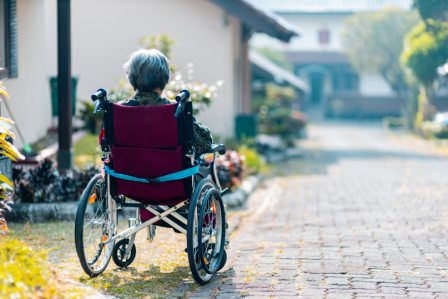
 I always tell people that one magical aspect of working with people with dementia is that you can still communicate, even if the affected person has lost the ability to speak coherently. I think that people with dementia develop a gift, which is the ability to communicate in a nontraditional way. This forces “us,” the unaffected persons, to learn their language. It is a language with pure emotions, spelled out by facial expressions and body language.
I always tell people that one magical aspect of working with people with dementia is that you can still communicate, even if the affected person has lost the ability to speak coherently. I think that people with dementia develop a gift, which is the ability to communicate in a nontraditional way. This forces “us,” the unaffected persons, to learn their language. It is a language with pure emotions, spelled out by facial expressions and body language.
In my work with those with dementia here in Vermont, I began to learn that new language, and watch those with dementia learn it, too. I will never forget a time when I was working as an activities assistant at a nursing home, and saw two of the patients laughing and appearing to tell stories to one another. Curious about what was so funny, I drew myself closer to them. To my astonished ears, I discovered they were not using sentences that made any sense. I could not follow their conversation as “Marion” was discussing the children she used to work with and “Lorraine” was pointing to a man across the room and commenting on his clothing. I could sense by their bodies leaning in toward one another, and by their smiling eyes and mouths, that they felt they were having a perfectly legitimate conversation. I soon learned to communicate with them in a similar fashion. Before long, I shared laughter with “Lorraine,” although I was unsure if we were laughing about the same thing. The content of our conversations was not as important as the emotion behind it.
As I became fluent in their language, I developed intimate relationships with my patients. Though once perhaps labeled “the Alzheimer’s patients who misbehave and get angry,” these were people with true feelings, upset over the idea of not understanding why they could not go to work, or why their children were not coming home from school. I began to realize that addressing their feelings in the moment is the most important thing of all. It didn’t matter if they mourned for their deceased husband as if he had just died yesterday, what mattered is that you connected with them in their reality.
Always liking to travel, I took a two two-month volunteer position in Helsinki, Finland, at a residential care home for people with dementia. I was curious to learn about how their universal health care affected elders, where older people resided, and if the philosophy of dementia care differed from what I knew in the United States, along with other things. Prior to leaving, I regularly emailed the volunteer coordinator, Riikka, at the home. I had read in the literature about Finland that the majority of people speak English. What the literature neglected to tell me, and what Riikka informed me, is that this is only true of those under the age of 60 or so—those above 60 had not learned it in school as the younger population had. I began to have my doubts about whether the volunteer work would be satisfying if I could not talk with the elders. How I loved to hear stories from the older population. Without this, would the experience be gratifying?
Upon starting the volunteer work, I found Riikka to be extremely kind. She gave me the grand tour of the two-story home for the elders, included me in all sorts of activities, answered a plethora of questions and was more than willing to translate what the residents were saying. My questions ranged from “What is the patient to staff ratio here?” to “How do the patients pay for the homes?” and “What is the philosophy of care around dementia care?”
Through Riikka’a translation, she introduced me to the patients. Many were excited to meet a “young lady” from the United States. They were eager to share their culture, telling me stories about growing up in the Finnish countryside, what they did for work, what their families were like, what the common foods they ate were, how they celebrate holidays, what it was like during wars, the difference between a Swedish speaking Finn and Finnish speaking Finn, etc. One lady had been to New York City and this was the basis for her view on the United States. She said she could never live in a country with so many people and tall buildings. I tried to tell her Vermont was different, but this notion was incomprehensible to her.
As I had in Vermont in my work at a residential care home, I began to develop relationships with the residents despite our language barrier. Mostly, I noticed this development through nonverbal cues such as smiling, hand holding, and acceptance of me participating in their activities, including dining. Some of them would recognize me as I came each day, and would say “hi” in English. One resident, Mia, spoke several languages. She could recall that I wasn’t Finnish, but could not recall that I was American. Consequently, she would greet me each day in a different language, sometimes French, sometimes German and sometimes English.
With the residents, I enjoyed doing chair exercises, dancing together, singing songs, having meals, mushroom foraging and going on daily walks. One walk with them stands out in my memory. As we got ready to leave, the staff began pairing up with some of the patients to help them walk and ensure they had no falls. I was hoping to walk with Mia or another resident who at least could say a few English phrases. Instead, the staff paired me with Eiya, a resident with warm eyes who didn’t know a single word of English. We began walking outdoors, down the road, toward the wooded trail. It was a pleasant autumn day with the leaves changing and wind slightly blowing. Eiya began speaking to me in Finnish. In my limited Finnish, I muttered back one of the few phrases I knew—“I do not speak Finnish.” She would nod, then not even a minute later start speaking in Finnish again, as she had forgotten what I had just said. As she spoke she would smile, point at a bird, glance at me and smile some more. Soon, I began doing the same thing is return: I would point to a pretty tree, make a comment on the number of bunnies, and simply smile with her. I began uttering back to her as she spoke, “Kylla, kylla” which basically translates to “Yeah, yeah,” And what do you know? Our conversation went along just fine.
This experience walking with Eiya confirmed my belief that nonverbal communication and connecting with emotions is the basis of the language of dementia. I now feel more strongly than ever that you can always, regardless of language or of verbal ability, communicate with someone with dementia. You just have to be patient and learn the language.
This article was contributed by Carrie Shamel, MSW.
 Related Articles & Free Subscription
Related Articles & Free Subscription
Important Legal Documents All Seniors Should Have
Is Hearing Loss a Sign of Dementia?






Comment here